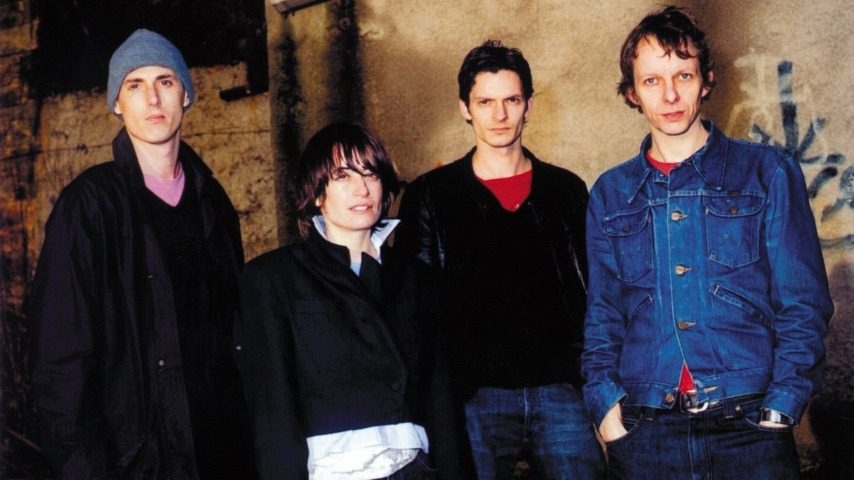Over the last two weeks, a certain weird bit of news about a specific band has slowly spread across social media platforms that middle-aged people actually use, namely Twitter and Facebook, and the reaction is always the same: “Wait, the TikTok kids have discovered Life Without Buildings?”
Life Without Buildings, the cult Scottish band who released one beloved album in 2001 and then broke up the next year, is the latest TikTok fad this side of sea shanties. Over the last few weeks, thousands of TikTok users, largely young women, have posted videos of themselves singing, dancing, and emoting along to the band’s first single “The Leanover.” There’s even a subset of videos of people doing their makeup or coloring their hair while lip-syncing the song. In other words, they’re fairly standard TikTok videos, with young people expressing and entertaining themselves through music, only with an obscure but amazing song by an obscure but amazing band that broke up almost 20 years ago. As of today, there’s been over 72,000 of these videos; here’s a small selection.
TikTok’s ability to turn songs into hits is well-established, and this is far from the first time an older song has been rediscovered by today’s youth through social media. This particular instance feels uniquely personal for many long-time Life Without Buildings fans, though. That’s a result not just of the band’s music, which is defined by singer Sue Tompkins’ elliptical style and poetic lyrics—both evocative and emotional even as they highlight the fundamental shortcomings of language—but also because, for many fans, Life Without Buildings still feels like a secret they somehow stumbled across. If you like Life Without Buildings, you probably love them; when their one album, Any Other City, connects with a listener, it often hits hard and deep, and the fact that it wasn’t a big success at the time, and didn’t develop as large a cult following as other cult records of the era, can make fans feel even more protective of it.
The band, meanwhile, are excited about the unexpected attention. “I was immediately struck by the fact it was predominantly young women getting into it and sharing their videos,” Tompkins told Paste via email. “I was really moved by that and mostly how you could see them just purely expressing themselves, and hopefully feeling loads of freedom!
“That makes me feel really excited that they feel they can do that and be seen so easily and accessibly,” she adds. “Everything is open and somehow seems incredibly sensitive and sincere and transparent at the same time. When I sang the song live in any context really, whether it was in rehearsals with the band or actually recording it in a studio or live on stage, I think deep down I always felt a sense of freedom and energy. And I used to like that!”
“It’s amazing,” says guitarist Robert Dallas Gray. “I don’t think they all like the song, some of them are making fun of it, and that’s fine too obviously. It’s really nice that it’s being taken very much as a pop song.”
Gray, who first became aware of the trend around Christmas, was initially confused by the whole thing. “I don’t use TikTok, so I didn’t really understand what was going on, and then a friend posted me a link to all the videos, like 50,000 of them, and it seemed like something was happening,” he says.
no fucking way is life without buildings being used on 19k tiktok’s like this hahahaha pic.twitter.com/BqeWFY5zuu
— LaurenN (@1aurenmoose) January 11, 2021
When a song gets memed on TikTok, that attention spills out to other platforms, and Life Without Buildings has seen a dramatic increase in its Spotify audience since the start of 2021. “We had about 30,000 monthly listeners on Spotify, and that’s gone up to 220,000 since Christmas,” Gray reveals. “I doubt that means much in terms of revenue or whatever but it’s a load of new people discovering the record, which is very gratifying, 20 years down the line.” It’s also perfect timing for this surprise influx of new listeners: Any Other City officially turns 20 next month, and this newfound spotlight will no doubt increase the amount of awareness that anniversary would’ve otherwise received. (Author’s note: I actually co-owned the label that released Any Other City in America later in 2001, but that license ran out in 2006, and whatever money might’ve been made from that release never made it back from the distributor.)
TikTok, of course, is a medium that nobody could’ve predicted back in 2001. Cell phones were still novel, mainstream smartphones and YouTube were years away, and social media was an absolute non-factor. (Friendster, one of the first popular social media networks, didn’t even exist until 2002.) Blogs hadn’t even really hit mainstream consciousness yet. The internet was already widespread, but the idea of people using a phone to post short videos of them pantomiming obscure songs for anybody in the world to watch was some straight-up sci-fi business back when “The Leanover” was first released. And if you’ve ever heard anybody over the age of, say, 30 mention TikTok, there’s a good chance it was in a demeaning, condescending tone.
You won’t hear that from Life Without Buildings, though. Tompkins sees TikTok as what it is: an avenue for unfettered self-expression. “I think TikTok is perfect for expressing yourself in any way you like,” she says. “It’s so immediate and diverse and fast, and the essence of that, I think, is amazing. I’m not sure why or how it started with women particularly, singing the first few lines of [“The Leanover”], but it’s really brilliant seeing these women just doing it, enjoying it and getting into the song!”
Tompkins especially loves how personal some of these videos are, how candidly the users perform for their followers.“I love the fact that many of the videos show the women in their own bedrooms and bathrooms, their homes and just these personal spaces where they can feel totally safe and free to film themselves,” Tompkins says. “I find that very empowering for all women really! Long live TikTok and music and letting go and freeeeedom!!”
For Tompkins, these videos reflect what “The Leanover” meant for her when she first performed it over 20 years ago. “I think at the core, ‘The Leanover,’ maybe because it was one of our very first songs, felt then, and still does now to me, like a big freedom release, and I hope it still sounds like that to new listeners to it. I hope so at least!”
One of the sad results of the band’s untimely breakup was that they never played any shows in America. A potential tour was in the early stages of being discussed in 2002 before the band broke up. As Life Without Building’s following has grown over the years, following a posthumous live album in 2007 and an Any Other City reissue in 2014, fans have desperately hoped the band would follow in the footsteps of so many other bygone indie rock groups and reunite for some live shows. This sudden TikTok resurgence, along with Any Other City’s anniversary, has breathed more life into the hopes that Life Without Buildings might one day play again, whenever it’s safe for bands to perform and go on tour.
But don’t count on that happening. Gray literally typed out a laugh when responding to that question via Twitter direct message. “Ha ha, no I don’t think so,” he writes. “We’re all cast to the four winds, have kids and jobs, etc. The amount of rehearsal we’d need to do to make it halfway worth doing is just completely impractical, even if we wanted to do it, and I think the consensus is we should just let the past be the past.”
The past might be just that for the four members of Life Without Buildings, but Any Other City will never grow old. Its TikTok fame is just another reminder of how timeless this music is, and how it’ll always be waiting for future generations to rediscover in their own way. Who knows what kind of impossible future tech the kids of 2040 will be using to find old bands to get excited about?
Senior editor Garrett Martin writes about videogames, comedy, music, travel, theme parks, wrestling, and more. He’s on Twitter @grmartin.




